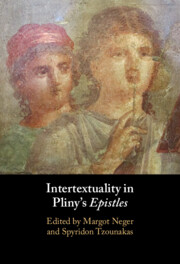Book contents
- Intertextuality in Pliny’s Epistles
- Intertextuality in Pliny’s Epistles
- Copyright page
- Contents
- Contributors
- Acknowledgements
- Abbreviations
- Introduction
- Part I Intertextuality and Interdiscursivity in Pliny’s Letters
- Part II Models and Anti-Models: Pliny’s Interaction with Oratory and Natural History
- Part III Pliny and Seneca: Discourses of Grief and Posthumous Reputation
- Part IV Pliny’s Villas and Their Poetic Models
- Part V Pliny Turns Nasty: Satire and the Scoptic Tradition
- Part VI Final Thoughts: Discourses of Representation and Reproduction
- Bibliography
- General Subject Index
- Index Locorum
Introduction
Published online by Cambridge University Press: 07 September 2023
- Intertextuality in Pliny’s Epistles
- Intertextuality in Pliny’s Epistles
- Copyright page
- Contents
- Contributors
- Acknowledgements
- Abbreviations
- Introduction
- Part I Intertextuality and Interdiscursivity in Pliny’s Letters
- Part II Models and Anti-Models: Pliny’s Interaction with Oratory and Natural History
- Part III Pliny and Seneca: Discourses of Grief and Posthumous Reputation
- Part IV Pliny’s Villas and Their Poetic Models
- Part V Pliny Turns Nasty: Satire and the Scoptic Tradition
- Part VI Final Thoughts: Discourses of Representation and Reproduction
- Bibliography
- General Subject Index
- Index Locorum
Summary
The introduction outlines the polyphonic and interactive character of Pliny the Younger’s Epistles by first looking at how Pliny constructs time and space of literary interaction in his social environment. The chapter then moves on with a discussion of interdiscursivity and generic interaction in Pliny’s letters and a review of scholarship on intertextuality. A case study of the triptych of letters 4.26-28 demonstrates how various forms of textual and non-textual interaction are combined in Pliny’s Epistles. Whereas the centrepiece of this series, Ep. 4.27 on the recitation of Sentius Augurinus’ poetry, focuses on oral exchange and mnemonic skills, the preceding letter (4.26) foregrounds the materiality of literature by playing with the motif of books as companions (comites) on journeys. The third letter (Ep. 4.28), on the other hand, emphasizes the visibility of famous writers whose portraits were placed and looked at in libraries. In addition to staging various forms of literary interaction, the triptych of Ep. 4.26-28 also showcases the letters’ intermediality. The introduction concludes with a key to the volume’s chapters.
Keywords
- Type
- Chapter
- Information
- Intertextuality in Pliny's Epistles , pp. 1 - 26Publisher: Cambridge University PressPrint publication year: 2023

